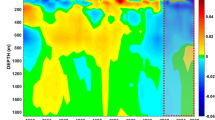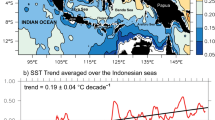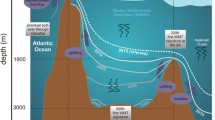Abstract
The warming of deep waters in the Nordic seas is identified based on observations during Chinese 5th Arctic Expedition in 2012 and historical hydrographic data. The most obvious and earliest warming occurrs in the Greenland Basin (GB) and shows a coincident accelerated trend between depths 2 000 and 3 500 m. The observations at a depth of 3 000 m in the GB reveal that the potential temperature had increased from −1.30°C in the early 1970s to −0.93°C in 2013, with an increase of about 0.37°C (the maximum spatial deviation is 0.06°C) in the past more than 40 years. This remarkable change results in that deep waters in the center of the Lofton Basin (LB) has been colder than that in the GB since the year 2007. As for the Norwegian Basin (NB), only a slight trend of warming have been shown at a depth around 2 000 m since the early 1980s, and the warming amplitude at deeper waters is just slightly above the maximum spatial deviation, implying no obvious trend of warming near the bottom. The water exchange rate of the Greenland Basin is estimated to be 86% for the period from 1982 to 2013, meaning that the residence time of the Greenland Sea deep water (GSDW) is about 35 years. As the weakening of deep-reaching convection is going on, the abyssal Nordic seas are playing a role of heat reservoir in the subarctic region and this may cause a positive feedback on the deep-sea warming in both the Arctic Ocean and the Nordic seas.
Similar content being viewed by others
References
Aagaard K, Carmack E C. 1989. The role of sea ice and other fresh water in the Arctic circulation. J Geophys Res, 94(C10): 14485–14498
Aagaard K, Swift J H, Carmack E C. 1985. Thermohaline circulation in the Arctic Mediterranean Seas. J Geophys Res, 90(C3): 4833–4846
Blindheim J, èsterhus S. 2013. The Nordic seas, main oceanographic features. In: Drange H, Dokken T, Furevik T, et al., eds. The Nordic Seas: An Integrated Perspective. Washington D C: American Geophysical Union
Blindheim J, Rey F. 2004. Water-mass formation and distribution in the Nordic Seas during the 1990s. ICES J Mar Sci, 61(5): 846–863
Budéus G, Schneider W, Krause G. 1998. Winter convective events and bottom water warming in the Greenland Sea. J Geophys Res, 103(C9): 18513–18527
Bullister J L, Weiss R F. 1983. Anthropogenic chlorofluoromethanes in the Greenland and Norwegian Seas. Science, 221(4607): 265–268
Carmack E, Aagaard K. 1973. On the deep water of the Greenland Sea. Deep-Sea Res: Oceanogr Abstr, 20(8): 687–715
Chang C W J, Chao Yi. 2000. A comparison between the World Ocean Atlas and Hydrobase climatology. Geophys Res Lett, 27(8): 1191–1194
Clarke R A, Swift J H, Reid J H, et al. 1990. The formation of Greenland Sea Deep Water: double diffusion or deep convection? Deep-Sea Res: Part A. Oceanographic Research Papers, 37(9): 1385–1424
Curry R G. 2002. Hydrobase 2: A database of hydrographic profiles and tools for climatological analysis. Woods Hole Oceanographic Institution, http://www.whoi.edu-/science/PO/hydrobase
Dickson R, Lazier J, Meincke J, et al. 1996. Long-term coordinated changes in the convective activity of the North Atlantic. In: Anderson D L, Willebrand J, eds. Decadal Climate Variability. Berlin, Heidelberg: Springer, 211–261
Dickson B, èsterhus S. 2007. One hundred years in the Norwegian Sea. Norsk Geografisk Tidsskrift — Norwegian Journal of Geography, 61(2): 56–75
Di Iorio D, Sloan C. 2009. Upper ocean heat content in the Nordic seas. J Geophys Res: Oceans, 114(C4): C04017
Furevik T, Mauritzen C, Ingvaldsen R. 2007. The flow of Atlantic water to the Nordic Seas and Arctic Ocean. In: èrbæk J B, Kallenborn R, Tombre I, et al., eds. Arctic Alpine Ecosystems and People in a Changing Environment. Berlin, Heidelberg: Springer, 123–146
Hansen B, èsterhus S. 2000. North Atlantic-Nordic seas exchanges. Prog Oceanogr, 45(2): 109–208
Karstensen J, Schlosser P, Wallace D W, et al. 2005. Water mass transformation in the Greenland Sea during the 1990s. J Geophys Res: Oceans, 110(C7): C07022
Langehaug H R, Falck E. 2012. Changes in the properties and distribution of the intermediate and deep waters in the Fram Strait. Prog Oceanogr, 96(1): 57–76
Lozier M S, Owens W B, Curry R G. 1995. The climatology of the North Atlantic. Prog Oceanogr, 36(1): 1–44
Malmberg S A. 1983. Hydrographic investigations in the Iceland and Greenland seas in late winter 1971. Deep Water Project. Jökull, 33: 133–140
Malmberg S A, Jónsson S. 1997. Timing of deep convection in the Greenland and Iceland Seas. ICES J Mar Sci, 54(3): 300–309
Meincke J, Jonsson S, Swift J H. 1992. Variability of convective conditions in the Greenland Sea. ICES J Mar Sci Symp, 195: 32–39
Meincke J, Rudels B, Friedrich H J. 1997. The Arctic Ocean-Nordic Seas thermohaline system. ICES J Mar Sci, 54(3): 283–299
Metcalf W G. 1955. On the formation of bottom water in the Norwegian Basin. Eos, Trans Am Geophys Union, 36(4): 595–600
Nansen F. 1906. Northern Waters: Captain Roald Amundsen’s Oceanographic Observations in the Arctic Seas in 1901. With a Discussion of the Origin of the Northern Seas. Dybwad: Christiana
èsterhus S, GammelsrØd T. 1999. The abyss of the Nordic seas is warming. J Climate, 12(11): 3297–3304
Peterson W H, Rooth C G H. 1976. Formation and exchange of deep water in the Greenland and Norwegian Seas. Deep-Sea Res: Oceanogr Abstr, 23(4): 273–283
Rhein M. 1991. Ventilation rates of the Greenland and Norwegian Seas derived from distributions of the chlorofluoromethanes F11 and F12. Deep-Sea Res: Part A. Oceanographic Research Papers, 38(4): 485–503
Rossby T, Prater M D, SØiland H. 2009. Pathways of inflow and dispersion of warm waters in the Nordic seas. J Geophys Res, 114(C4): C04011
Rudels B. 1986. The -S relations in the northern seas: implications for the deep circulation. Polar Res, 4(2): 133–159
Rudels B, Korhonen M, Budéus G, et al. 2012. The East Greenland Current and its impacts on the Nordic Seas: observed trends in the past decade. ICES J Mar Sci, 69(5): 841–851
Schlosser P, Bönisch G, Rhein M, et al. 1991. Reduction of deepwater formation in the Greenland Sea during the 1980s: evidence from tracer data. Science, 251(4997): 1054–1056
Schott F, Visbeck M, Fischer J. 1993. Observations of vertical currents and convection in the central Greenland Sea during the winter of 1988–1989. J Geophys Res, 98(C8): 14401–14421
Smethie J W M, Ostlund H G, Loosli H H. 1986. Ventilation of the deep Greenland and Norwegian seas: evidence from krypton-85, tritium, carbon-14 and argon-39. Deep-Sea Res Part A. Oceanographic Research Papers, 33(5): 675–703
Somavilla R, Schauer U, Budéus G. 2013. Increasing amount of Arctic Ocean deep waters in the Greenland Sea. Geophys Res Lett, 40(16): 4361–4366
Swift J H. 1986. The Arctic waters. In: Hurdle B G, ed. The Nordic Seas. New York: Springer, 124–156
Swift J H, Aagaard K. 1981. Seasonal transitions and water mass formation in the Iceland and Greenland seas. Deep-Sea Res Part A. Oceanographic Research Papers, 28(10): 1107–1129
Swift J H, Koltermann K P. 1988. The origin of Norwegian Sea deep water. J Geophys Res, 93(C4): 3563–3569
Swift J H, Takahashi T, Livingston H D. 1983. The contribution of the Greenland and Barents seas to the deep water of the Arctic Ocean. J Geophys Res, 88(C10): 5981–5986
Visbeck M, Rhein M. 2000. Is bottom boundary layer mixing slowly ventilating Greenland Sea deep water? J Phys Oceanogr, 30(1): 215–224
Voet G, Quadfasel D, Mork K A, et al. 2010. The mid-depth circulation of the Nordic seas derived from profiling float observations. Tellus A, 62(4): 516–529
Author information
Authors and Affiliations
Corresponding author
Additional information
Foundation item: The National Natural Science Foundation of China under contract No. 41330960; the Chinese Polar Environmental Comprehensive Investigation and Assessment Programs under contract Nos CHINARE2013-04-03 and CHINARE2012-03-01.
Rights and permissions
About this article
Cite this article
Wang, X., Zhao, J., Li, T. et al. Deep waters warming in the Nordic seas from 1972 to 2013. Acta Oceanol. Sin. 34, 18–24 (2015). https://doi.org/10.1007/s13131-015-0613-z
Received:
Accepted:
Published:
Issue Date:
DOI: https://doi.org/10.1007/s13131-015-0613-z




